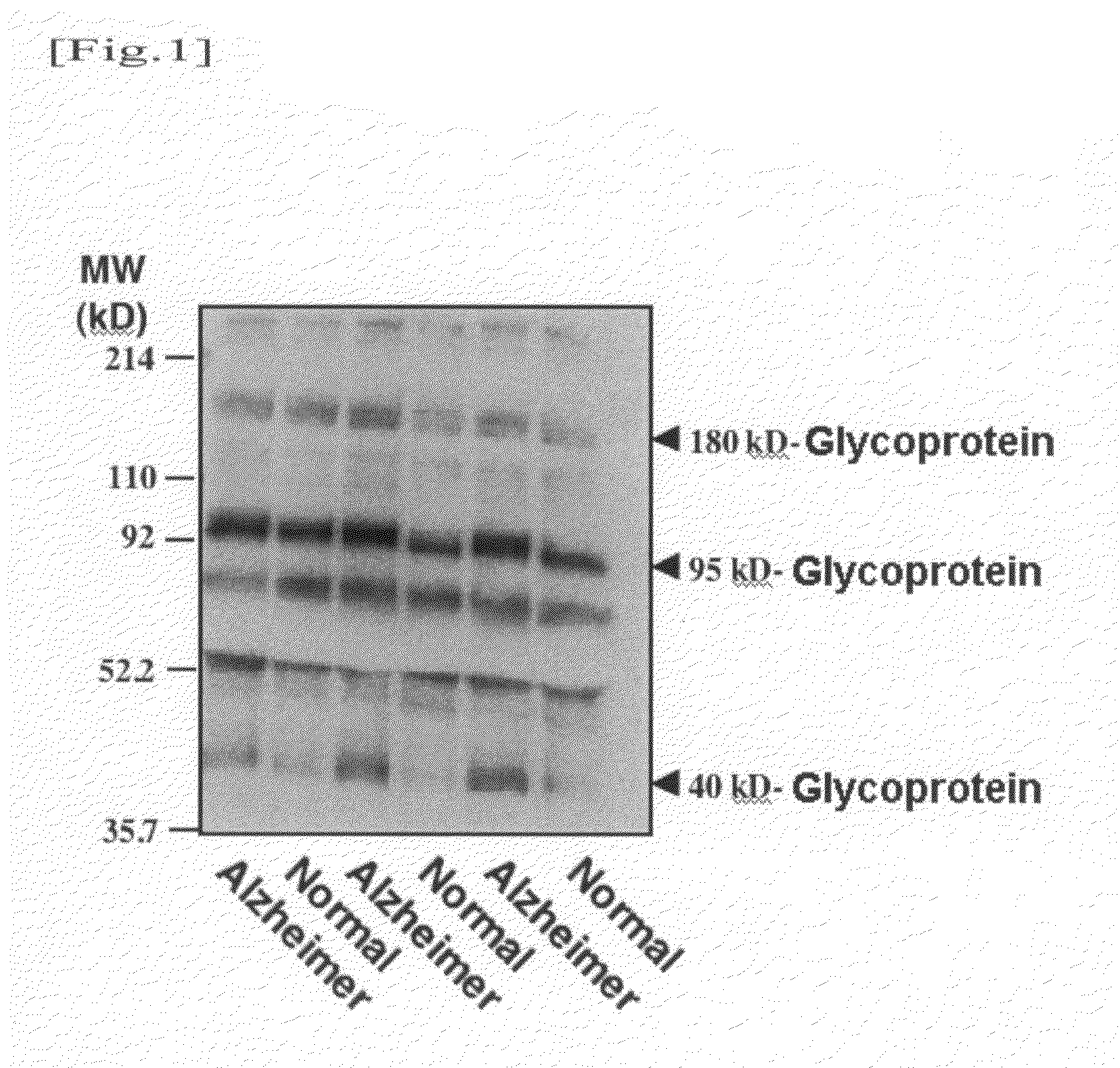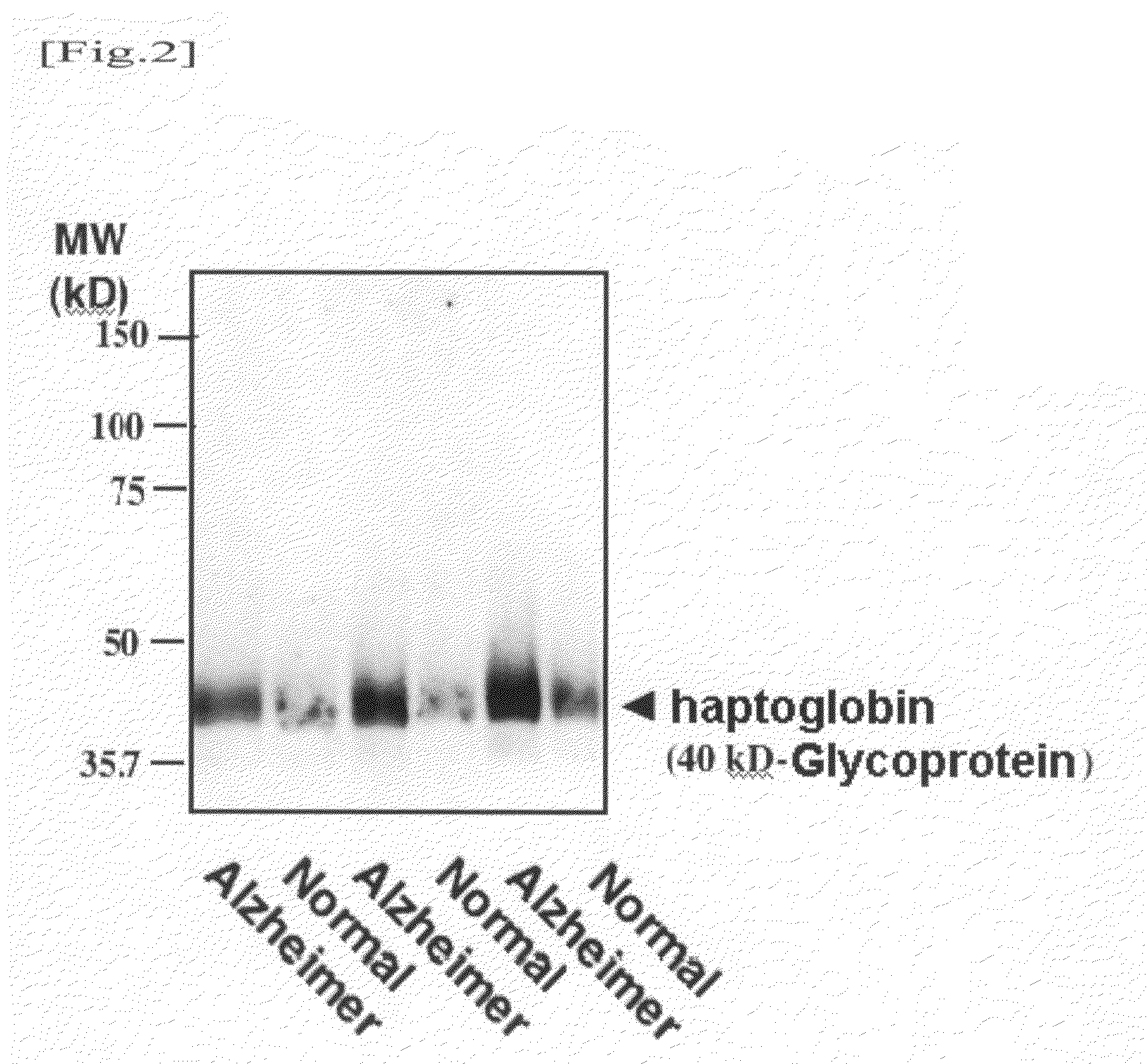Method for diagnosing alzheimer's disease using serum glycoprotein as biomarker
a technology of alzheimer's disease and serum glycoprotein, which is applied in the field of alzheimer's disease diagnostic agents and methods, can solve the problems of neuron death already progressing, a peptide cannot be used as an early diagnostic marker, and it is theoretically difficult to use such a trace amount of a as a diagnostic marker, so as to increase the activity of -secretase, increase the activity of -secretas
- Summary
- Abstract
- Description
- Claims
- Application Information
AI Technical Summary
Benefits of technology
Problems solved by technology
Method used
Image
Examples
example 1
Detection of α2,6-Sialyl Residue-Containing Glycoprotein by Lectin-Blotting Method
[0049]A human serum or plasma sample (corresponding to 20 μg of protein) was mixed with a Laemmli sample buffer, and the mixture was then heated. Thereafter, the mixture was subjected to SDS / PAGE using 4 / 20% gradient polyacrylamide gel. Electrophoresis was performed at a constant current of 40 mA for 55 minutes. The separated protein was electrically transcribed onto a PVDF membrane at a constant current of 260 mA for 50 minutes. Thereafter, the membrane was blocked in 1% bovine serum albumin (BSA)-phosphate buffered saline (PBS) for one or more hours. Thereafter, biotinylated lectin (SSA) diluted with 1% BSA-PBS was allowed to react with the PVDF membrane for 1 hour. (In this experiment, biotin-SSA (#300442; Seikagaku Corp.) was used in a concentration of 1 μg / ml.) The membrane was washed three times with 0.05% Tween 20 (surfactant) in PBS for 15 minutes for each time. Thereafter, the resultant was al...
example 2
Western Blotting Method
[0050]Taking into consideration the fact that such glycoproteins contain α2,6-sialyl residue and the molecular weights thereof, an attempt was made to identify a 180-kD glycoprotein, a 95-kD glycoprotein, and a 40-kD glycoprotein. An antibody reacting with a human serum glycoprotein used as a candidate was purchased and examined. As a result, it was found that the 40-10 glycoprotein is haptoglobin. A detection method thereof will be described below.
[0051]A human serum or plasma sample (corresponding to 0.04 μg of protein) was mixed with a Laemmli sample buffer, and the mixture was then heated. Thereafter, the mixture was subjected to SDS / PAGE using 4 / 20% gradient polyacrylamide gel. Electrophoresis was performed at a constant current of 40 mA for 55 minutes. The separated protein was electrically transcribed onto a PVDF membrane at a constant current of 260 mA for 50 minutes. Thereafter, the membrane was blocked in 5% skimmed milk-0.1% Tween 20 in Tris buffere...
PUM
| Property | Measurement | Unit |
|---|---|---|
| diameter | aaaaa | aaaaa |
| diameter | aaaaa | aaaaa |
| constant current | aaaaa | aaaaa |
Abstract
Description
Claims
Application Information
 Login to View More
Login to View More - R&D
- Intellectual Property
- Life Sciences
- Materials
- Tech Scout
- Unparalleled Data Quality
- Higher Quality Content
- 60% Fewer Hallucinations
Browse by: Latest US Patents, China's latest patents, Technical Efficacy Thesaurus, Application Domain, Technology Topic, Popular Technical Reports.
© 2025 PatSnap. All rights reserved.Legal|Privacy policy|Modern Slavery Act Transparency Statement|Sitemap|About US| Contact US: help@patsnap.com


